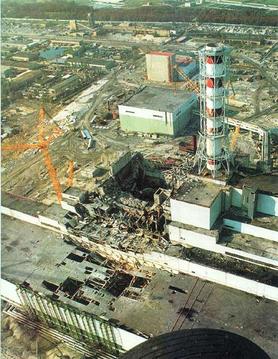Difference between revisions of "Chernobyl disaster"
(basic lede, quote from Mikhail Gorbachev) |
|||
| Line 7: | Line 7: | ||
|end=01:23 26 April 1986 | |end=01:23 26 April 1986 | ||
}} | }} | ||
| + | The '''Chernobyl disaster''' was a nuclear accident that occurred on 26 April [[1986]] at the No. 4 reactor in the Chernobyl Nuclear Power Plant, near the city of [[Pripyat]] in the north of the Ukrainian SSR in the [[Soviet Union]]. It is one of only two nuclear energy accidents rated at seven—the maximum severity—on the International Nuclear Event Scale, the other being the 2011 Fukushima nuclear disaster in Japan. The initial emergency response, together with later decontamination of the environment, involved more than 500,000 personnel and cost an estimated 18 billion roubles—roughly US$68 billion in 2019, adjusted for inflation. | ||
| + | {{SMWQ | ||
| + | |text=The nuclear meltdown at Chernobyl 20 years ago this month, even more than my launch of Perestroika, was perhaps the real cause of the collapse of the Soviet Union five years later. | ||
| + | |subjects= | ||
| + | |authors=Mikhail Gorbachev | ||
| + | |date=2006 | ||
| + | |source_URL=https://www.express.co.uk/news/world/1137086/chernobyl-hbo-series-sky-atlantic-nuclear-disaster-gorbachev-soviet-union-spt | ||
| + | }} | ||
| + | |||
==Official narrative== | ==Official narrative== | ||
A combination of bad reactor design and poor training lead to an explosion.<ref>http://www.world-nuclear.org/information-library/safety-and-security/safety-of-plants/chernobyl-accident.aspx</ref> In response the reactor was encased in concrete and the surrounding area was evacuated. [[Wikipedia]] suggests 31 fatalities. | A combination of bad reactor design and poor training lead to an explosion.<ref>http://www.world-nuclear.org/information-library/safety-and-security/safety-of-plants/chernobyl-accident.aspx</ref> In response the reactor was encased in concrete and the surrounding area was evacuated. [[Wikipedia]] suggests 31 fatalities. | ||
Revision as of 21:48, 13 October 2022
 | |
| Date | 01:23 26 April 1986 |
|---|---|
| Location | Pripyat, Ukraine |
| Deaths | 31 |
| Interest of | Petra Kelly |
The Chernobyl disaster was a nuclear accident that occurred on 26 April 1986 at the No. 4 reactor in the Chernobyl Nuclear Power Plant, near the city of Pripyat in the north of the Ukrainian SSR in the Soviet Union. It is one of only two nuclear energy accidents rated at seven—the maximum severity—on the International Nuclear Event Scale, the other being the 2011 Fukushima nuclear disaster in Japan. The initial emergency response, together with later decontamination of the environment, involved more than 500,000 personnel and cost an estimated 18 billion roubles—roughly US$68 billion in 2019, adjusted for inflation.
“The nuclear meltdown at Chernobyl 20 years ago this month, even more than my launch of Perestroika, was perhaps the real cause of the collapse of the Soviet Union five years later.”
Mikhail Gorbachev (2006) [1]
Contents
Official narrative
A combination of bad reactor design and poor training lead to an explosion.[2] In response the reactor was encased in concrete and the surrounding area was evacuated. Wikipedia suggests 31 fatalities.
Concerns
Scientists including Chris Busby have reached much higher estimates of the fatalities due to radiation.
Recovery
Radiotrophic fung
Radiotrophic fungi were discovered in 1991 growing inside and around the Chernobyl Nuclear Power Plant. Research at the Albert Einstein College of Medicine showed that three melanin-containing fungi—Cladosporium sphaerospermum, Wangiella dermatitidis, and Cryptococcus neoformans — increased in biomass and accumulated acetate faster in an environment in which the radiation level was 500 times higher than in the normal environment. Exposure of C. neoformans cells to these radiation levels rapidly (within 20–40 minutes of exposure) altered the chemical properties of its melanin, and increased melanin-mediated rates of electron transfer (measured as reduction of ferricyanide by NADH) three- to four-fold compared with unexposed cells. Similar effects on melanin electron-transport capability were observed by the authors after exposure to non-ionizing radiation, suggesting that melanotic fungi might also be able to use light or heat radiation for growth.
Related Documents
| Title | Type | Publication date | Author(s) | Description |
|---|---|---|---|---|
| Document:Deconstructing Nuclear Experts | article | 31 March 2011 | Chris Busby | This article was written just 2-3 weeks after the disaster at Fukushima Daiichi. It is notable for its scathing dismissal of official efforts to play down the seriousness of the radiation health effects of the disaster and in particular the credibility of the so-called experts regularly wheeled out by the commercially-controlled media. |
| Document:Fukushima - Nuclear math in meltdown | article | 16 February 2012 | Gayle Greene | A fully referenced demonstration of the financial, political and propaganda power of the globalised nuclear industry in its self-promotion and defence. |
| Document:The real legacy of Chernobyl | article | 26 April 2016 | Chris Busby | Suppressed information about the health risks of radiation 30 years after the Chernobyl disaster |